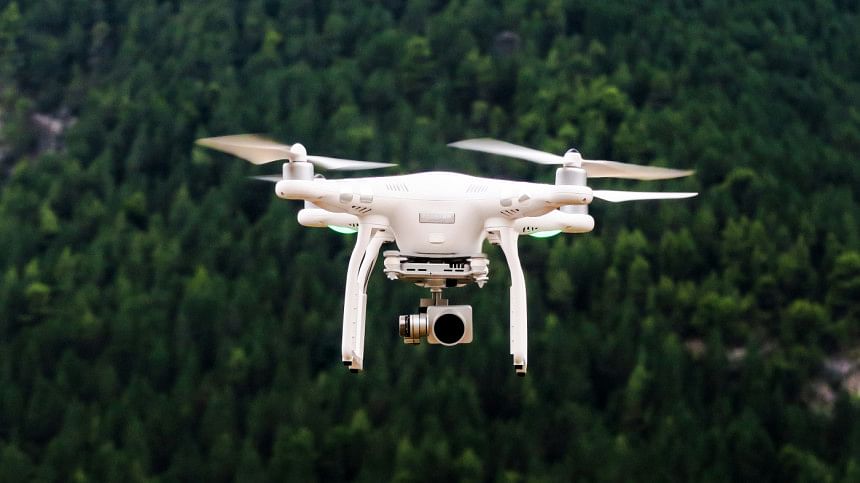New drone regulations in draft: licence and clearance to be mandatory

The Ministry of Civil Aviation and Tourism has put forward a comprehensive set of drone regulations aimed at strengthening control over the operation, import, and usage of drones in Bangladesh. The newly drafted "Drone Regulations 2024" introduce a stringent framework requiring operators to secure licences from the Civil Aviation Authority of Bangladesh (CAAB) for most types of drones, except for toy drones.
According to the draft, toy drones are classified as devices weighing less than 250 grams and lacking any audio or video recording capabilities. These toy drones can be flown using remote control up to a height of 100 metres without prior permission. However, all other categories of drones will now require a range of certifications and approvals to ensure that operators adhere to airspace regulations and maintain public safety.
The draft categorises drones into three main types: toy drones, general drones used for activities such as filming, surveying, or research, and drones capable of carrying people or cargo. For non-toy drones, operators must be at least 16 years old, and they are required to undergo specific training and obtain a certificate of competency from CAAB. Additionally, operators will need to demonstrate a clear understanding of airspace protocols.
The proposed regulations stipulate that each flight of non-toy drones must be authorised by CAAB, with clearance also required from multiple security agencies, including the Air Defence Operations Centre, Defence Intelligence Agency (DGFI), National Security Intelligence (NSI), and local police. This multi-layered approval process aims to mitigate risks associated with unauthorised drone use, which could potentially compromise public safety, state security, or aviation operations.
The regulations divide airspace into three distinct zones:
Green zone: Toy drones can be flown without prior approval up to 60 metres (approximately 200 feet).
Yellow zone: Areas near airports, densely populated regions, and public gatherings. Permission from CAAB will be required to fly drones in these areas.
Red zone: Strictly restricted areas such as military bases, sensitive government installations, and border areas. Flying drones in these zones will require special authorisation from CAAB, along with clearance from security agencies.
Additionally, drones will not be allowed to operate within two kilometres of events involving Very Very Important Persons (VVIPs) for a period of three days prior to such events, unless special permission is obtained.
Mandatory registration and import restrictions
The draft mandates that all drones, other than toys, must be registered with CAAB. Operators are required to obtain a unique identification number for each drone. To complete the registration process, users must submit detailed documentation, including the intended purpose of the drone, technical specifications, purchase or import paperwork, and a no-objection certificate from the Ministry of Defence.
For importing drones or their parts, approval must be obtained from both the Ministry of Defence and the Ministry of Home Affairs. This regulation aims to control the entry of high-powered drones that could be misused for nefarious activities. Additionally, there is scope for setting up local drone manufacturing or assembly plants, provided they meet the guidelines set by the Ministry of Industry.
Penalties for violations
The regulations include provisions for strict penalties against those found operating drones without proper authorisation. If a drone flight endangers public safety, breaches state security, or disrupts air traffic, legal action can be taken under the Penal Code of 1860 and the CAAB Act of 2017. Penalties may include fines and imprisonment, depending on the severity of the infraction.
The government has opened the draft regulations for public feedback, allowing stakeholders to submit their opinions and suggestions until the end of November. This consultation period aims to refine the regulations before they are finalised and officially implemented.
How other countries fare in terms of drone regulations
Other countries have similarly stringent rules to address security and privacy concerns.
India's drone regulations, overseen by the Directorate General of Civil Aviation (DGCA), require all drone operators to obtain a Unique Identification Number (UIN) and an Operator Permit for most drones except for nano drones (weighing less than 250 grams) used for non-commercial purposes. Flights are limited to daytime operations and within visual line of sight. Additionally, drones are not permitted to fly above 400 feet, near airports, or over restricted zones without prior permission. The DGCA also mandates that drones be equipped with safety features such as GPS, anti-collision lights, and no-fly zone compliance.
In the United States, the Federal Aviation Administration (FAA) regulates drone usage under Part 107 of the Federal Aviation Regulations. Commercial drone operators must obtain a Remote Pilot Certificate and register their drones if they weigh more than 250 grams. Drones are restricted from flying over people, beyond the operator's visual line of sight, or above 400 feet without a waiver. Recently, the FAA introduced Remote ID requirements, which enable the identification of drones in flight, enhancing accountability and safety. The FAA has also designated no-fly zones, particularly around critical infrastructure and events.
The UK's Civil Aviation Authority (CAA) requires drone operators to pass an online theory test and obtain an Operator ID and Flyer ID for drones weighing over 250 grams. All drones with cameras are subject to data protection laws to ensure privacy. Flights are restricted to a maximum altitude of 400 feet, and drones must remain within the visual line of sight of the operator. The UK has also established geo-fenced no-fly zones around sensitive areas, such as airports, military installations, and high-profile public events.

 For all latest news, follow The Daily Star's Google News channel.
For all latest news, follow The Daily Star's Google News channel. 



Comments